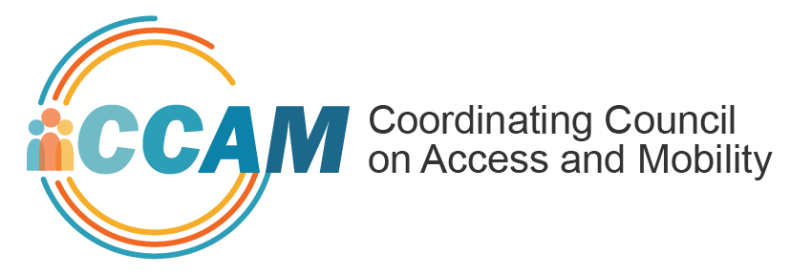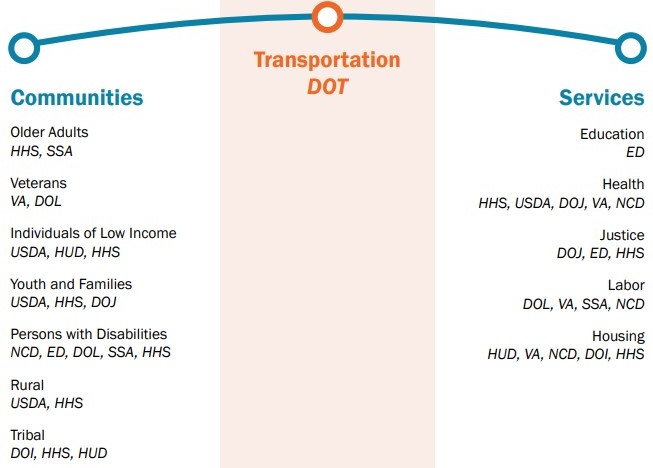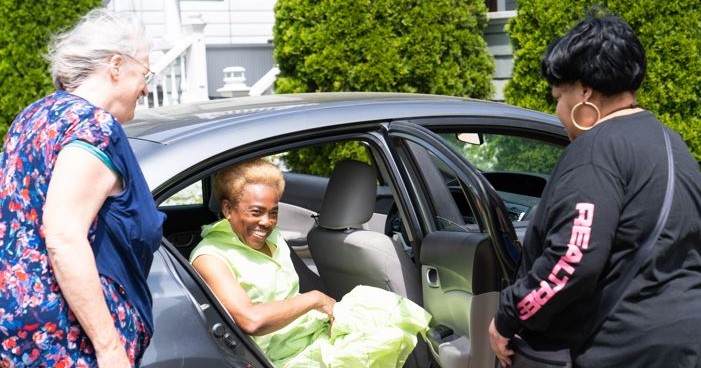Coordinating Council on Access and Mobility
Learn More About the CCAM

CCAM Members | CCAM Multisector Partner Directory | CCAM-Related Interagency Initiatives |CCAM-Related Reports | FAQs | 2023 – 2026 CCAM Strategic Plan | CCAM Program Inventory | CCAM Federal Fund Braiding Guide
What's New
- On July 1, 2025, FTA published an update to the Charter Service Regulation. The final rule removed the outdated federal financial assistance programs listed in Appendix A, and FTA clarified that Qualified Human Service Organizations (QHSOs) receiving funding under one or more of the programs in the CCAM Program Inventory are not required to register on the FTA charter service website to receive charter service from a recipient; reducing the administrative burden of charter registration for many QHSOs. Learn more here.
- In July 2025, the CCAM updated the CCAM Multisector Partner Directory, which now includes over 100 national partner organizations relevant to CCAM. The directory provides a comprehensive view of stakeholders across transportation, health, housing, and other sectors. Each listing includes a description, CCAM association, and focus areas, making it easier for CCAM Members and partners to find and coordinate cross-sector partnerships.
- In May 2025, the CCAM updated the CCAM Program Inventory, which identifies 132 federal programs that may provide funding for human services transportation for individuals with disabilities, older adults, and individuals of low income. The updated program inventory includes detailed program information, such as Assistance Listing Numbers (formerly Catalog of Federal Domestic Assistance (CFDA)), statutory references, types of recipients and beneficiaries, and eligible transportation activities. Alongside the Program Inventory, CCAM developed the Federal Fund Braiding Guide, which defines federal fund braiding for local match and provides guidance to potential grantees and CCAM agency program managers on acceptable arrangements for transportation-related projects.
Overview
The Coordinating Council on Access and Mobility (CCAM) is a federal interagency council that works to coordinate funding and provide expertise on human services transportation. Human services transportation fosters personal mobility by connecting people to their homes, jobs, education, medical appointments, and all their communities have to offer.
The CCAM focuses on programs for three targeted populations: individuals with disabilities, older adults, and individuals of low income. The CCAM was:
- Established in 2004 by Executive Order 13330
- Referenced in a note to 49 U.S.C. 101 since 2006, which identifies the CCAM as supporting several objectives of the USDOT
- Given tasks by Congress in 2015, in Section 3006(c) of the 2015 Fixing America’s Surface Transportation (FAST) Act.
The CCAM works to improve federal coordination of transportation resources and address barriers faced by states and local communities when coordinating transportation. Led by the DOT Secretary, its mission is to issue policy recommendations and implement activities that improve the availability, accessibility, and efficiency of transportation for CCAM’s targeted populations.
View the CCAM’s 20th Anniversary Video showcasing recent accomplishments.
CCAM Structure

The Secretary of Transportation chairs the CCAM, and 10 additional federal department and agency leaders form the remaining CCAM membership. Nine of the 11 total CCAM members include:
- Department of Agriculture (USDA)
- Department of Education (ED)
- Department of Health and Human Services (HHS)
- Department of Housing and Urban Development (HUD)
- Department of Interior (DOI)
- Department of Justice (DOJ)
- Department of Labor (DOL)
- Department of Transportation (DOT)
- Department of Veterans Affairs (VA)
These agencies currently support grant programs that can fund human services transportation. The additional two CCAM members— the National Council on Disability and the Social Security Administration— provide valuable expertise to enhance the CCAM’s ability to serve its targeted populations.
Technical Assistance
The Transportation Technical Assistance Coordination Library provides a sustainable methodology and platform to access resources through transportation technical assistance centers and FTA.
For additional technical assistance information and resources, visit the FTA-Sponsored Technical Assistance, Training, and Research Resource Programs webpage.
Transportation Coordination

Coordinated transportation involves multiple entities working together to deliver one or more components of a transportation service with the shared goal of increasing capacity to provide trips. Coordination activities can include sharing passenger trips and vehicles, co-location of facilities, programs or services, collaborating on grant applications, state/local plans, training, vehicle purchasing or maintenance, joint hiring of mobility manager(s), federal fund braiding, and more. Visit the Transportation Coordination website to learn more.
